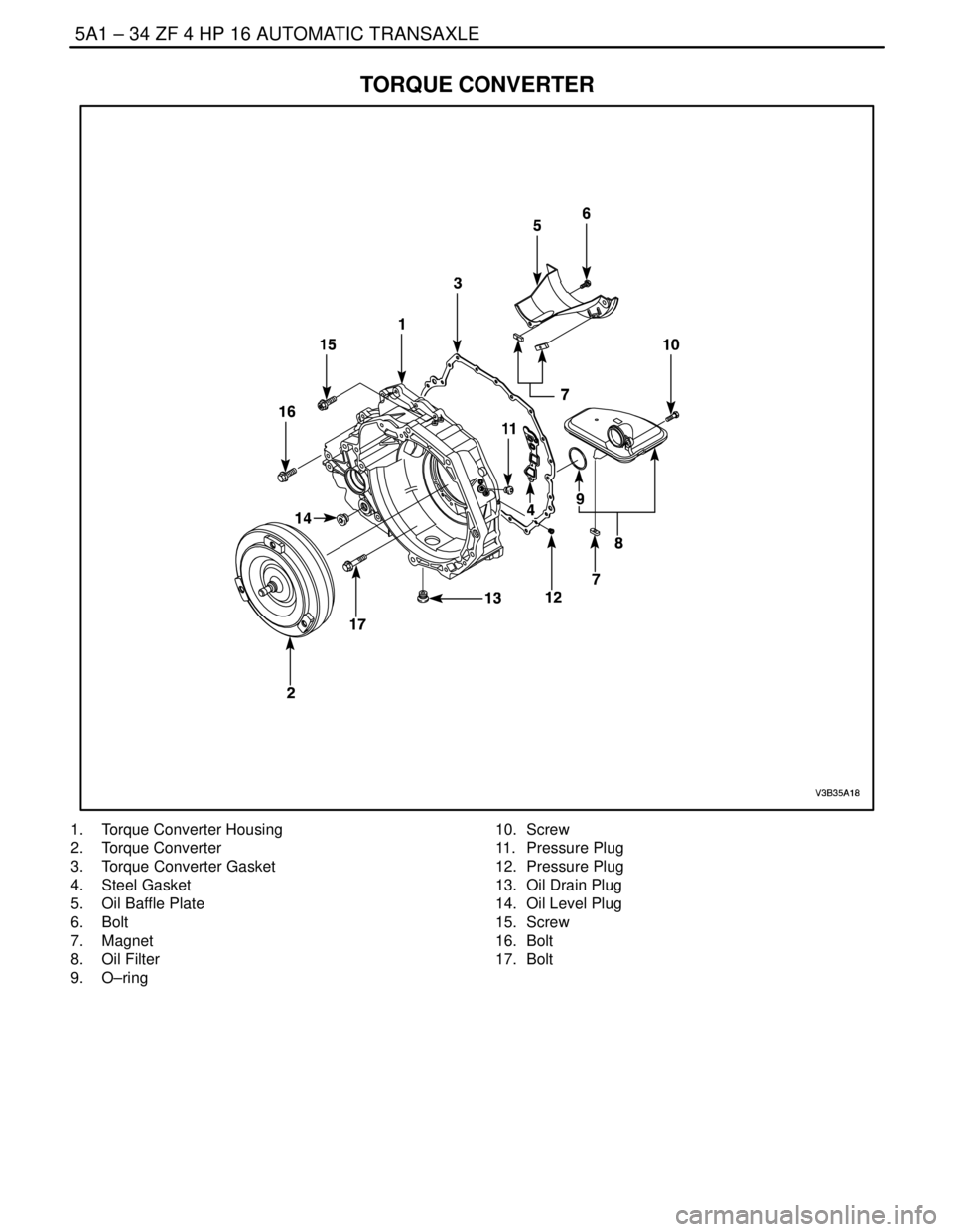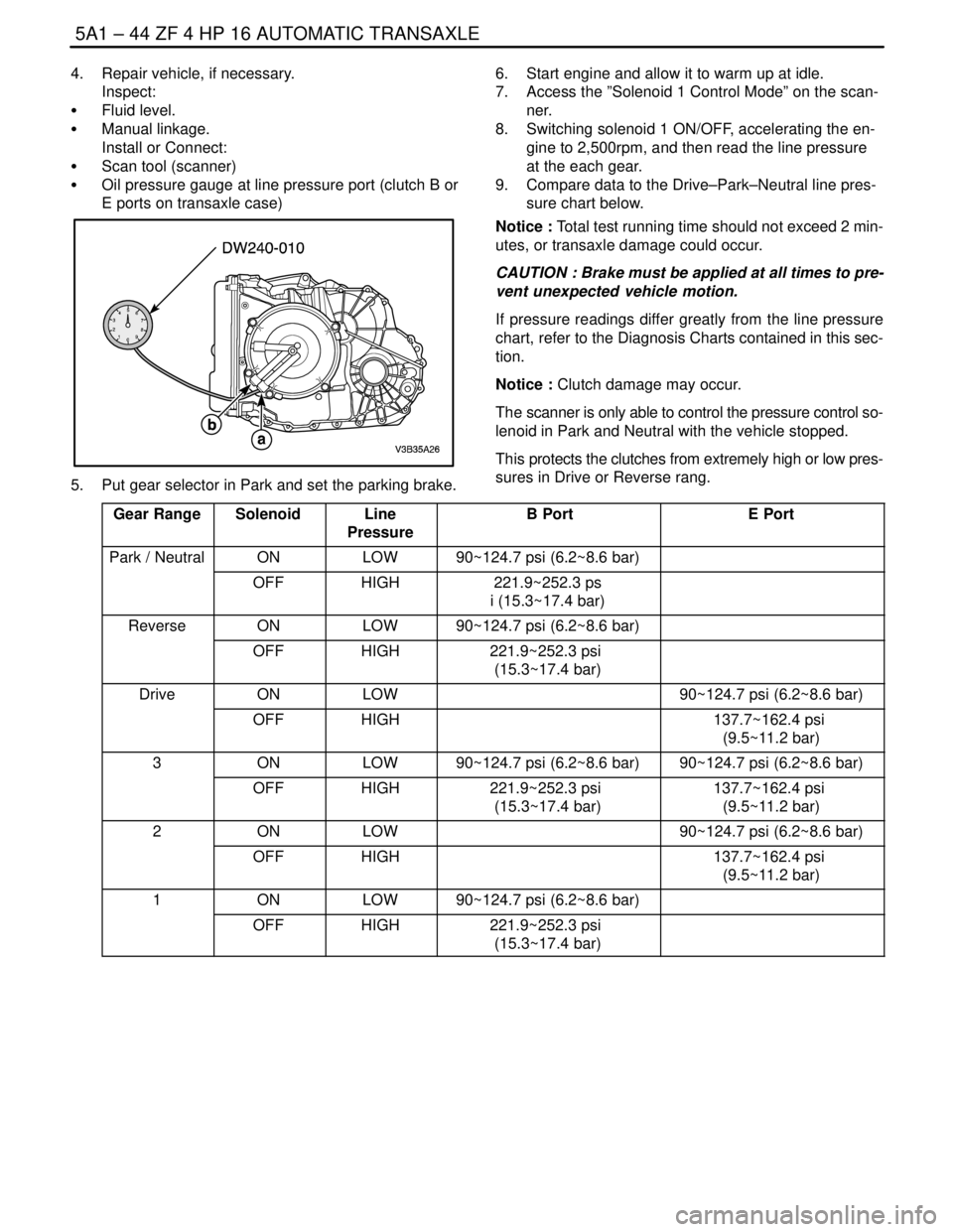2004 DAEWOO LACETTI oil level
[x] Cancel search: oil levelPage 1355 of 2643

5A1 – 6IZF 4 HP 16 AUTOMATIC TRANSAXLE
DAEWOO V–121 BL4
Application Lb–InLb–Ft NSm
Fluid Level Plug4533–
Line Pleasure Plugs2015–
Valve Housing 1 Cover Attachment Bolts6–53
Solenoid Valve Attachment Bolts6–53
Pressure Control Regulator(EDS) Attachment Bolts6–53
Oil Cooler Inlet Pipe Bolts3526–
Oil Cooler Outlet Pipe Bolts3526–
Shift Control Cable Adjuster Pinch Nut8–71
Shift Control Cable Attachment Nut8–71
Upper Transaxle–to–Engine Bolts7555–
Selector Lever(On Transaxle Case)1511–
Torque Converter Attachment Bolts4533–
Shift Control Assembly Mounting Bolt, Nut8–71
Lower Engine–to–Transaxle Bolts(a)7555–
Lower Engine–to–Transaxle Bolt(b)2115–
Lower Engine–to–Transaxle Bolts(c)3123–
Rear Transaxle Mounting Bracket Bolts6245–
Damping Block Connection Bolt and Nut6850–
Left Transaxle Mount Bracket Cage Bolt(a)11 081–
Left Transaxle Mount Bracket Cage Bolt(b)6548–
Left Transaxle Mount Bracket Cage Nut(c)6548–
Left Transaxle Mounting Bolts4835–
Page 1367 of 2643

5A1 – 18IZF 4 HP 16 AUTOMATIC TRANSAXLE
DAEWOO V–121 BL4
Park/Neutral
In Park or Neutral with the engine running there is no drive
to the planetary gear set. Line pressure (from the oil pump)
is supplied to the valve body. Only clutch B is supplied and
the torque converter is released.
Control
Line Pressure Control Valve
The line pressure control valve sets the general pressure
level in the valve body. When gearshifts are not taking
place, the line pressure varies between two levels, de-
pending on the turbine torque. Line pressure increase lin-
early by time. But it has a limit point. When pressure reach-
es that point, excess oil pressure drains back into the oil
sump.
Reduction Valve
The reduction valve reduces the line pressure with which
the downstream solenoid valves and pressure control so-
lenoid valves (EDS) are supplied. This makes it possible
to use smaller solenoid valves.
The line pressure comes from the oil pump and flows to the
reduction valve. The inlet port to the reduction valve will be
blocked and line pressure will be maintained at the ap-
propriate level.
Solenoid Valve 1, 2
Solenoid Valve 1 controls the line pressure (high and low)
to the clutch valves. Solenoid Valve 1 is either ON or OFF.
When the solenoid is turned ON the line pressure will be
low [87~116psi (6~8bar)].When the solenoid is turned
OFF the line pressure will be high [232~261psi
(16~18bar)].
Solenoid 2 controls the fluid flow to clutch valve E or the
TCC clutch valve. When solenoid 2 is ON fluid is directed
to the TCC pressure valve and if the solenoid is switched
OFF fluid will flow to the inlet at clutch valve E.The TCM monitors numerous inputs to determine the ap-
propriate solenoid state combination and transaxle gear
for the vehicle operating conditions.
In Park and Neutral solenoid valve 1 is ON. So line pres-
sure flows to the safety valve and the line pressure control
valve via the solenoid valve.
Clutch B Engaged
In Park and Neutral solenoid valves 1 and 2 are both ON.
Pressure control solenoids (EDS) 4 and 6 are also turned
ON.
When EDS 6 is ON, the fluid supplied from the reduction
valve flows to the safety valve, clutch valve B and holding
valve B. The oil that is supplied to the inlet port of the clutch
valve presses on the valve spool. Line pressure then flows
to the holding valve and check ball, engaging clutch B.
Lock–up Clutch (TCC)
Solenoid 2 is turned ON and the line pressure control
valves spool will be depressed. Fluid will now flow through
the torque converter pressure valve.
As a result, the oil pressure behind the converter lock–up
clutch piston and in the turbine zone is equal. The direction
of flow is through the turbine shaft and through the space
behind the piston, to the turbine chamber.
Lubrication/Cooling.
The lubricating valve ensures that the converter is sup-
plied with cooling oil first if the pump rate is low. The lubri-
cating pressure valve in addition guarantees that the nec-
essary amount of cooling and lubricating oil is available via
the bypass duct.
The fluid, which is supplied from the torque converter,
flows to the cooler via the lubrication valve.
Page 1377 of 2643

5A1 – 28IZF 4 HP 16 AUTOMATIC TRANSAXLE
DAEWOO V–121 BL4
Drive Range – Fourth Gear
In Drive 4, transaxle drive is via the input shaft and
clutches E and C. The elements of this transaxle function
are as follows:
S Clutch E is engaged to drive the rear planetary gear
carrier.
S The rear planetary gear carrier drives the rear ring
gear.
S The rear ring gear carrier drives the differential
gear.
Control
Clutch E Engaged
Solenoid 2 will be switched OFF. Line pressure, which is
supplied by the reduction valve, flows to the inlet port of
clutch valve E. Fluid will then pass through the clutch valve
and clutch E will engage.Clutch C Engaged
EDS 4 will be switched OFF causing the fluid level to be
high. Line pressure will be directed to the safety valve,
clutch valve D and holding valve D. Clutch valve C and
holding valve C will engage as pressure flows through the
safety valve.
Lock–up Clutch
Solenoid valve 2 is turned ON and the line pressure control
valve spool will be depressed. Fluid will now flow through
the torque converter pressure valve.
As a result, the oil pressure behind the converter lock–up
clutch piston and in the turbine zone is equal. The direction
of flow is through the turbine shaft and through the space
behind the piston, to the turbine chamber.
Page 1383 of 2643

5A1 – 34IZF 4 HP 16 AUTOMATIC TRANSAXLE
DAEWOO V–121 BL4
TORQUE CONVERTER
1. Torque Converter Housing
2. Torque Converter
3. Torque Converter Gasket
4. Steel Gasket
5. Oil Baffle Plate
6. Bolt
7. Magnet
8. Oil Filter
9. O–ring10. Screw
11. Pressure Plug
12. Pressure Plug
13. Oil Drain Plug
14. Oil Level Plug
15. Screw
16. Bolt
17. Bolt
Page 1392 of 2643

ZF 4 HP 16 AUTOMATIC TRANSAXLE 5A1 – 43
DAEWOO V–121 BL4
DIAGNOSTIC INFORMATION AND
PROCEDURES DIAGNOSIS
BASIC KNOWLEDGE REQUIRED
You must be familiar with some basic electronics to use
this section of the Service Manual. They will help you to
follow diagnostic procedures.
Notice : Lack of the basic knowledge of this transaxle
when performing diagnostic procedures could result in in-
correct diagnostic performance or damage to transaxle
components.
Do not, under any circumstances, attempt to diagnose a
transaxle problem without this basic knowledge.
Notice : If a wire is probed with a sharp instrument and not
properly sealed afterward, the wire will corrode and an
open circuit will result.
Diagnostic test probes are now available that allow you to
probe individual wires without leaving the wire open to the
environment. These probe devices are inexpensive and
easy to install, and they permanently seal the wire from
corrosion.
Special Tools
You should be able to use a Digital Volt Meter (DVM), a cir-
cuit tester, jumper wires or leads and a line pressure gauge
set.
The functional check procedure is designed to verify the
correct operation of electronic components in the trans-
axle.
This will eliminate the unnecessary removal of transaxle
components.
FUNCTIONAL CHECK PROCEDURE
Begin with the Functional Check Procedure which pro-
vides a general outline of how to diagnose automatic
transaxle. The following functional check procedure will in-
dicate the proper path of diagnosing the transaxle by de-
scribing the basic checks and then referencing the loca-
tions of the specific checks.
S Check the fluid level according to the Fluid Level
Service Procedure.
S Check the transaxle for fluid leaks.
S Check if the transaxle fluid is not burnt by color and
smell.
S Ensure that the transaxle is not in Limp Home
Mode(LHM).
S Check the battery terminals and the ground con-
nections for corrosion or looseness.
S Check that the cooler flow is not restricted.S Check all electrical connections for tightness.
S Use on–board diagnostic tool or a scan tool to see
if any transaxle trouble codes have been set. Refer
to the appropriate ”Diagnostic Trouble Code (DTC)”
information and repair the vehicle as directed. After
repairing the vehicle, perform the road test and
verify that the code has not set again.
S Perform the Electrical/Garage Shift Tests.
S Perform the Road Test Procedure in this section.
S Inspect the oil and check for metal or other contam-
inants in the oil pan.
LINE PRESSURE CHECK
PROCEDURE
The 4HP 16 A/T uses a trochoid type oil pump to produce
hydraulic pressure, and a pressure control solenoid (sole-
noid 1) to control that pressure at the pressure regulator
valve, after it leaves the pump. The transaxle pressure
control solenoid is controlled by an electrical signal that
ranges from 0 to 12 volts corresponds to minimum line
pressure (approx. 89.9 to 124.7 psi (6.2 to 8.6 bar)) and
0 volt corresponds to a maximum line pressure (approx.
221.9 to 252.4 psi (15.3 to 17.4 bar)) in all range.
Line pressures are calculated for two sets of gear ranges
– Drive–Park–Neutral and Reverse. This allow the trans-
axle line pressure to be appropriate for different pressure
needs in different gear ranges:
Gear
Range
Solenoid
1RPMPressure
Drive,
ReverseOff2,500221.9~252.4psi
(15.3~17.4 bar)
On2,50017.4~269.8psi
(1.2~18.6 bar)
Neutral,
ParkOff2,500221.9~252.4psi
(15.3~17.4 bar)
On2,50089.9~269.8 psi
(6.2~18.6 bar)
Before performing a line pressure check, verify that the
pressure control solenoid is receiving the correct electrical
signal from the TCM:
1. Install a scan tool.
2. Start the engine and set parking brake.
3. Check for a stored pressure control solenoid diag-
nostic trouble code, and other diagnostic trouble
codes.
Page 1393 of 2643

5A1 – 44IZF 4 HP 16 AUTOMATIC TRANSAXLE
DAEWOO V–121 BL4
4. Repair vehicle, if necessary.
Inspect:
S Fluid level.
S Manual linkage.
Install or Connect:
S Scan tool (scanner)
S Oil pressure gauge at line pressure port (clutch B or
E ports on transaxle case)
5. Put gear selector in Park and set the parking brake.6. Start engine and allow it to warm up at idle.
7. Access the ”Solenoid 1 Control Mode” on the scan-
ner.
8. Switching solenoid 1 ON/OFF, accelerating the en-
gine to 2,500rpm, and then read the line pressure
at the each gear.
9. Compare data to the Drive–Park–Neutral line pres-
sure chart below.
Notice : Total test running time should not exceed 2 min-
utes, or transaxle damage could occur.
CAUTION : Brake must be applied at all times to pre-
vent unexpected vehicle motion.
If pressure readings differ greatly from the line pressure
chart, refer to the Diagnosis Charts contained in this sec-
tion.
Notice : Clutch damage may occur.
The scanner is only able to control the pressure control so-
lenoid in Park and Neutral with the vehicle stopped.
This protects the clutches from extremely high or low pres-
sures in Drive or Reverse rang.
Gear Range
SolenoidLine
Pressure B PortE Port
Park / NeutralONLOW90~124.7 psi (6.2~8.6 bar)
OFFHIGH221.9~252.3 ps
i (15.3~17.4 bar)
ReverseONLOW90~124.7 psi (6.2~8.6 bar)
OFFHIGH221.9~252.3 psi
(15.3~17.4 bar)
DriveONLOW90~124.7 psi (6.2~8.6 bar)
OFFHIGH137.7~162.4 psi
(9.5~11.2 bar)
3ONLOW90~124.7 psi (6.2~8.6 bar)90~124.7 psi (6.2~8.6 bar)
OFFHIGH221.9~252.3 psi
(15.3~17.4 bar)137.7~162.4 psi
(9.5~11.2 bar)
2ONLOW90~124.7 psi (6.2~8.6 bar)
OFFHIGH137.7~162.4 psi
(9.5~11.2 bar)
1ONLOW90~124.7 psi (6.2~8.6 bar)
OFFHIGH221.9~252.3 psi
(15.3~17.4 bar)
Page 1394 of 2643

ZF 4 HP 16 AUTOMATIC TRANSAXLE 5A1 – 45
DAEWOO V–121 BL4
CLUTCH PLATE DIAGNOSIS
Composition Plates
Dry the plate and inspect the plates for the following condi-
tions :
S Pitting
S Flaking
S Wear
S Glazing
S Cracking
S Charring
Chips or metal particles embedded in the lining
Replace a composition plate which shows any of these
conditions.
Steel Plates
Wipe the plates dry and check the plates for heat discolor-
ation. If the surfaces are smooth, even if colorsmear is in-
dicated, you can reuse the plate. If the plate is discolored
with hot spots or if the surface is scuffed, replace the plate.
Important : If the clutch shows evidence or extreme heat
or burning, replace the springs.
Causes of Burned Clutch Plates
The following conditions can result in a burned clutch
plate:
S Incorrect usage of clutch plates.
S Engine coolant in the transaxle fluid.
S A cracked clutch piston.
S Damaged or missing seals.
S Low line pressure.
S Valve problems.
– The valve body face is not flat
– Porosity between channels
– The valve bushing clips are improperly installed.
– The check balls are misplaced.
S The seal rings are worn or damaged
Engine Coolant in Transaxle
Notice : Antifreeze will deteriorate the O–ring seals and
the glue used to bond the clutch material to the pressure
plate. Both conditions may cause transaxle damage.
Perform the following steps if the transaxle oil cooler has
developed a leak, allowing engine coolant to enter the
transaxle:
1. Because the coolant will attach to the seal material
causing leakage, disassemble the transaxle and
replace all rubber type seals.
2. Because the facing material may become sepa-
rated from the steel center portion, replace the
composition faced clutch plate assemblies.
3. Replace all nylon parts including washers.
4. Replace the torque converter.
5. Thoroughly clean and rebuild the transaxle, using
new gaskets and oil filter.6. Flush the cooler lines after you have properly re-
paired or replaced the transaxle.
COOLER FLUSHING AND FLOW
TEST
Notice : You must flush the cooler whenever you receive
a transaxle for service. Cooler flushing is essential for
SRTA installation, major overhaul, whenever you replace
a pump or torque converter, or whenever you suspect that
the fluid has been contaminated.
After filling the transaxle with fluid, start the engine and run
for 30 seconds. This will remove any residual moisture
from the oil cooler. Disconnect the return line at the trans-
axle and observe the flow with the engine running. If the
fluid flow is insufficient, check the fluid flow by disconnect-
ing the feed line at the cooler. Observe the flow with the
engine running.
S If the flow from the cooler return line at the trans-
axle is insufficient, check the flow rate from the feed
line to the cooler. BLockage exists in the transaxle
or the cooler.
S If the flow from the transaxle feed line to the cooler
is insufficient, the transaxle is the cause of the fluid
flow problem.
S If the flow the transaxle feed line to the cooler is
insufficient, but flow from the cooler return line to
the transaxle is insufficient, inspect the cooler pipes
and fittings. Then repeat the cooler flushing proce-
dure. If the flow is still insufficient, replace the cool-
er.
TRANSAXLE FLUID LEVEL SERVICE
PROCEDURE
This procedure is to be used when checking a concern
with the fluid level in a vehicle. A low fluid level will result
in slipping and loss of drive/ reverse or delay on engage-
ment of drive/ reverse when the vehicle is cold.
The vehicle is first checked for transaxle diagnostic mes-
sages on the scan tool. If the oil level is low, it is possible
to register a vehicle speed signal fault.
The vehicle is to be test driven to determine if there is an
abnormal delay when selecting drive or reverse, or loss of
drive. One symptom of low fluid level is a momentary loss
of drive when driving the vehicle around a corner. Also
when the transaxle fluid level is low, a loss of drive may oc-
cur when the transaxle fluid temperature is low.
When adding or changing transaxle fluid use only ESSO
LT 71141 automatic transaxle fluid or other approved
fluids. The use of incorrect fluid will cause the performance
and durability of the transaxle to be severely degraded.
Fluid Level Diagnosis Procedure
1. If the vehicle is at operating temperature allow the
vehicle to cool down for two hours, but no greater
than four hours. Or if the vehicle is at cool status,
start the engine and allow the engine to idle for
approximately 5 minutes (825~875 rpm), if pos-
Page 1395 of 2643

5A1 – 46IZF 4 HP 16 AUTOMATIC TRANSAXLE
DAEWOO V–121 BL4
sible, drive the vehicle for a few kilometers (N–D,
N–R, shift until two gear). This will allow the trans-
axle to be within the correct temperature range.
Transaxle fluid level should be checked at tempera-
ture 20 to 45°C (68 to 113°F).
CAUTION : Removal of the fluid filler plug when the
transaxle fluid is hot may cause injury if fluid drains
from the filler hole.
2. Switch off accessories, especially air conditioner,
heater.
3. With the brake pedal pressed, move the gear shift
control lever through the gear ranges, pausing a
few seconds in each range. Return the gearshift
lever to P(Park). Turn the engine OFF.
4. Park the vehicle on a hoist, inspection pit or similar
raised level surface. The vehicle must be level to
obtain a correct fluid level measurement.
5. Place a fluid container below the fluid filler plug.
6. Clean all dirt from around the fluid filler plug.
Remove the fluid filler plug. Clean the filler plug and
check that there is no damage to the ”O” ring.
S If fluid drains through the filler hole the transaxle
may have been overfilled. When the fluid stops
draining the fluid level is correct. Install the fluid
filler plug and tighten it to 45NSm(34 lb–ft).
S If fluid does not drain through the filler hole, the
transaxle fluid level may be low. Lower the ve-
hicle, and start the vehicle in P(Park) with the
parking brake and the brake applied. With the
engine idling, move the gear shift lever through
the gear ranges, pausing a few seconds in each
range and adding the fluid until gear application
is felt. Return the gear shift lever to P(Park).
Turn the engine OFF and raise the vehicle.
Check if the fluid level is aligned with the bottom
of the filler hole. If not, add a small quantity of
fluid to the correct level. Install the fluid filler
plug and tighten it to 45NSm(34 lb–ft).
7. When the fluid level checking procedure is com-
pleted, wipe any fluid around the filler plug with a
rag or shop towel.
Fluid Level Set After Service
1. Depending on the service procedure performed,
add the following amounts of fluid through the filler
plug hole prior to adjusting the fluid level:
Oil pan removal – 4 liters (4.23 quarts)
Converter removal – 2 liters ( 2.11 quarts)
Overhaul – 6.9liters (7.3 quarts)
Oil drain plug removal – 4 liters (4.23 quarts)
2. Follow steps 1 through 4 of the Fluid Level Diagno-
sis Procedure.
3. Clean all dirt from around the fluid filler plug.
Remove the fluid filler plug. Clean the filler plug and
check that there is no damage to the ”O” ring.
4. Lower the vehicle with the filler plug still removed
and start the vehicle in P(Park) with the parking
brake and the brake applied. With the engine idling,move the gear shift lever through the gear ranges,
pausing a few seconds in each range and adding
the fluid until gear application is felt. Then add an
additional 0.5 liters of fluid. Return the gear shift
lever to P(Park). Turn the engine OFF and raise the
vehicle. Install the fluid filler plug and tighten it to
45NSm (34 lb–ft).
5. Drive the vehicle at 2.2 miles(3.5km) to 2.8
miles(4.5 km) with light throttle so that the engine
does not exceed 2500 rpm. This should result in
the transaxle temperature being in the range 20 to
45°C (68 to 11°F). With the brake applied, move
the shift lever through the gear ranges, pausing a
few seconds in each range at the engine idling.
6. Return the gear shift lever to P(Park). Turn the en-
gine OFF and raise the vehicle on the hoist, if appli-
cable, ensuring the vehicle is level. When the three
minutes passed after the engine stopped, remove
the filler plug. Check if the fluid level is aligned with
the bottom of the filler hole. If not, add a small
quantity of fluid to the correct level. Install the fluid
filler plug and tighten it to 45NSm (34 lb–ft).
7. Wipe any fluid around the filler plug with a rag or
shop towel.
Fluid Leak Diagnosis and Repair
The cause of most external leaks can generally be Lo-
cated and repaired with the transaxle in the vehicle.
Methods for Locating Leaks
General Method
1. Verify that the leak is transaxle fluid.
2. Thoroughly clean the suspected leak area.
3. Drive the vehicle for approximately 25 km (15
miles) or until the transaxle reaches normal operat-
ing temperature (88°C, 190°F).
4. Park the vehicle over clean paper or cardboard.
5. Turn the engine OFF and look for fluid spots on the
paper.
6. Make the necessary repairs to correct the leak.
Powder Method
1. Thoroughly clean the suspected leak area.
2. Apply an aerosol type powder (foot powder) to the
suspected leak area.
3. Drive the vehicle for approximately 25 km (15
miles) or until the transaxle reaches normal operat-
ing temperature (88°C, 190°F).
4. Turn the engine OFF.
5. Inspect the suspected leak area and trace the leak
path through the powder to find the source of the
leak.
6. Make the necessary repairs.
Dye and Black Light Method
1. Add dye to the transaxle though the transaxle fluid
filler plug. Follow the manufacturer’s recommenda-
tion for the amount of dye to be used.
2. Use the black light to find the fluid leak.
3. Make the necessary repairs.